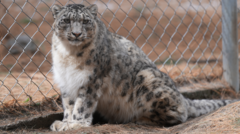In the rugged mountains of Gilgit-Baltistan, Pakistan, an innovative initiative aims to protect the endangered snow leopard population while safeguarding local farming communities from wildlife conflicts. The snow leopard, a majestic yet vulnerable predator, is believed to have a mere 4,000 to 6,000 individuals left in the wild, with about 300 residing in Pakistan. The World Wide Fund for Nature (WWF) reports that retaliatory killings in response to livestock losses contribute to a decline of 20% in their numbers over the past two decades.
Only weeks ago, a snow leopard named Lovely, orphaned at a young age, displayed her inability to hunt. After being raised in captivity for 12 years, she represents the complicated relationship between humans and this elusive species. "If we release her, she would just go attack a farmer's sheep and get killed," explains her caretaker, Tehzeeb Hussain.
To tackle the rising conflict, WWF Pakistan, in collaboration with the Lahore University of Management Sciences (LUMS), has developed AI-powered cameras capable of detecting snow leopards and sending alerts to farmers via text message. This proactive approach can enable livestock to be moved away from danger, decreasing the prospects for direct encounters that lead to retaliatory violence.
Positioned high in the snow-laden mountains, the cameras utilize solar panels and lithium batteries to ensure consistent operation. As conservationist Asif Iqbal illustrates, the cameras have undergone rigorous testing, focusing on effectively differentiating between humans, prey animals, and snow leopards to minimize false alarms.
However, the project is not without its hurdles. Initial skepticism among local communities manifested through damaged equipment and privacy concerns, as some villagers felt uncomfortable with increased surveillance. "We noticed some of the wires had been cut," recalls Iqbal, reinforcing the need for community engagement and trust.
Local farmer Sitara, who lost her six sheep to a snow leopard attack, expressed concerns about the effectiveness of the notifications, citing poor cellular service. Despite these issues, there is growing acknowledgment among some villagers about the ecological value of snow leopards. They play a crucial role in controlling prey populations, which in turn helps protect local grasslands.
While challenges remain, including adapting to the changing climate that forces human farmers and wildlife into closer proximity, WWF is seeking additional deterrents like smells, sounds, and lights to keep snow leopards at bay from populated areas. Community support remains crucial; as conservation efforts progress, there lies hope that technological innovation may indeed bridge the gap between human and wildlife needs in this mountainous region.






















